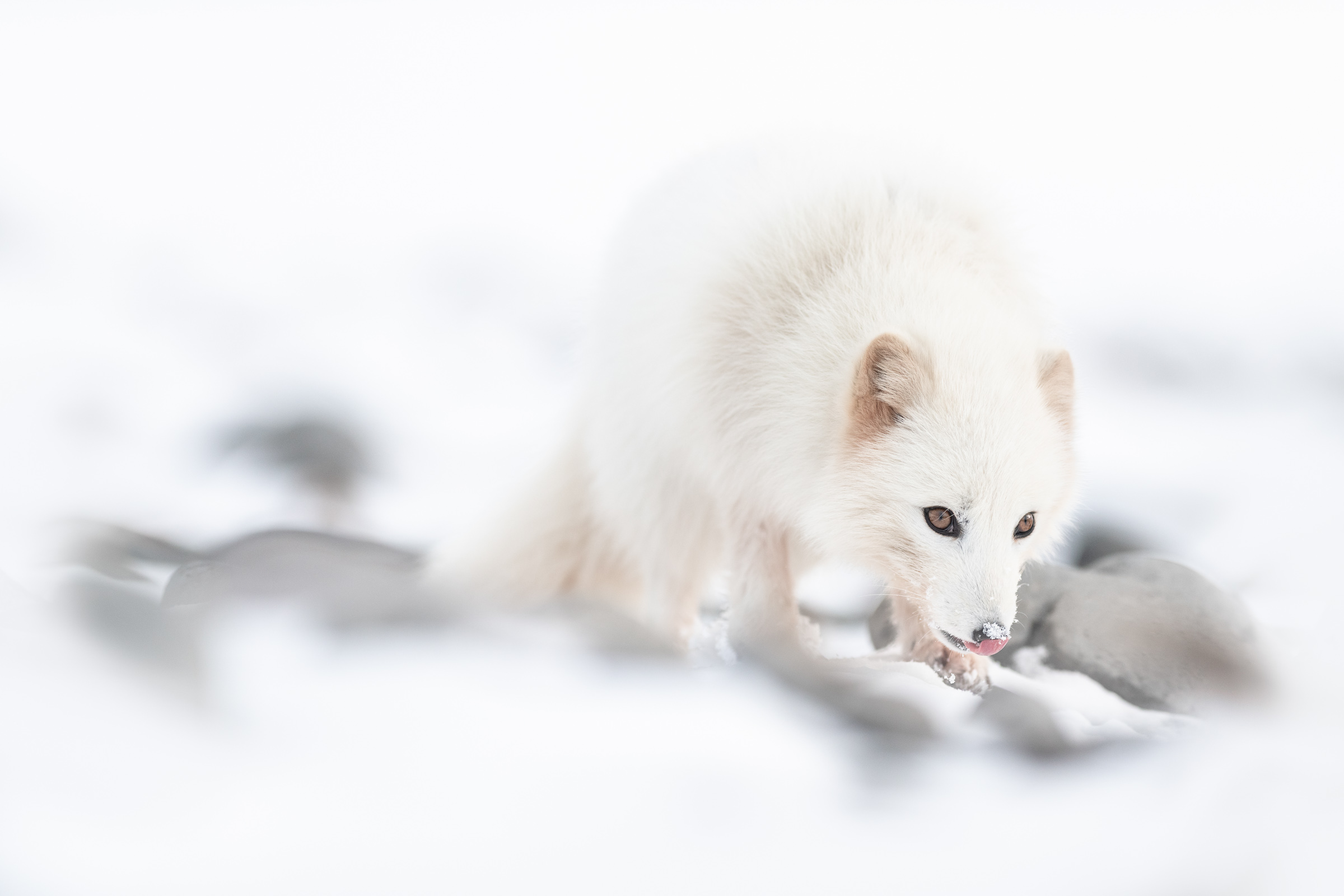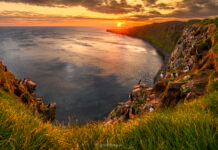It was in the middle of March. The world is being consumed by worries over the Covid-19 situation. We drove from our hometown Akureyri which is in North-Iceland to the town of Ísafjörður in the Westfjords on a beautiful sunny day. Despite good weather, there are mountain roads that are always risky passing. Steingrímsfjarðarheiði-heath was no exception on this beautiful day, but we passed it without problems thanks to the hardy people working on snowblowers.
The destination is Hornvík in the Hornstrandir area. It is a remote bay in the Nature Reserve where the wildlife is protected from hunting. This is one reason why it can be possible to photograph arctic foxes. This proved to be easier said than done.
Sailing from Ísafjörður to Hornvík takes between 3 and 4 hours depending on the weather. The forecast worried us. The wind was supposed to be quite calm early on the departure day which was possibly a window opportunity to go. If we would not make it through this window we would probably have to wait for 3 days for the next chance to sail.
It was a relief when the captain called and asked everyone to go to the harbor. We would be sailing as planned.
I had been in Hornvík in 2015 photographing the arctic foxes in the winter. When the boat got close to the bay after sailing in rather calm conditions I noticed there was more snow than in 2015. The snow in the whole north of Iceland had been heavy this winter and Hornvík was no exception.
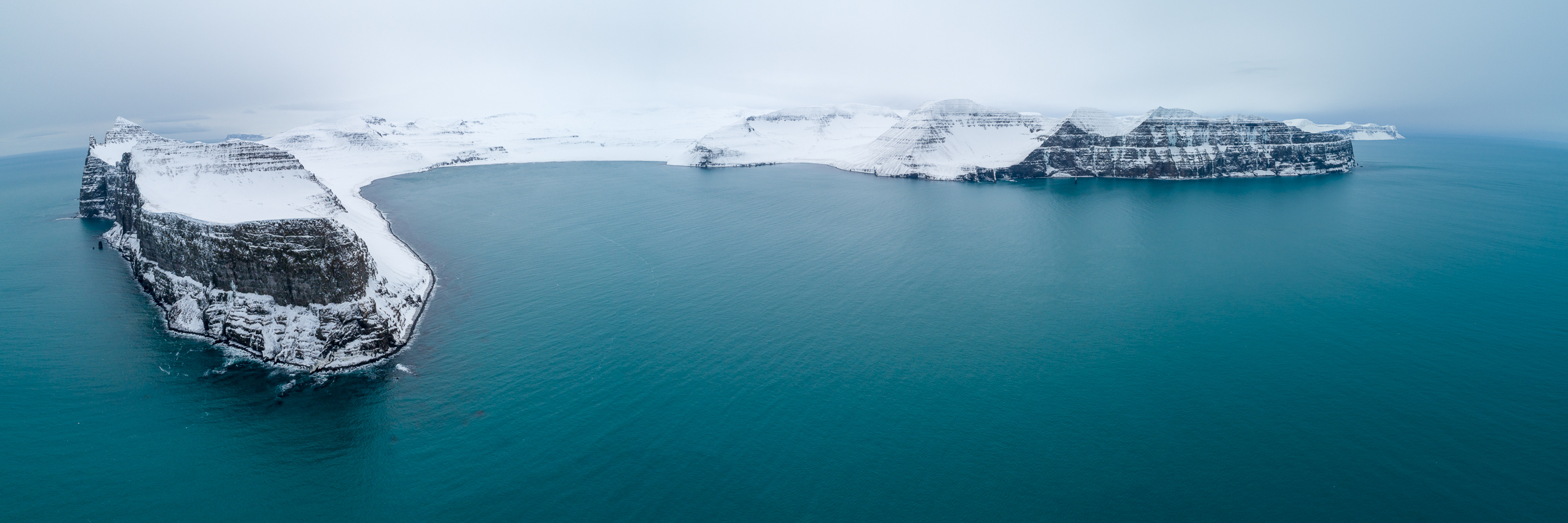
On arriving in Hornvík on the boat a fox could be seen wandering along the shore where the boat was heading. The weather was nice, with no wind and with a bit of imagination, you could see the sun in the clouds. It looked promising to see the fox from the boat.
This was the calm before the storm.
When darkness took over on the day of arrival, the wind picked up in the afternoon when the boat had left. Lying in bed during the night the noise and sounds of the storm beating the old house were out of this world. In a way, we were also out of this world. We were a group of seven people with one satellite phone to contact the world in case of an emergency. There was no other way of communicating with the world. No electricity in the house and no running water. Snow had to be melted over the gas stove to get water for drinking and outside the house, there was a water hole we had to dig snow and ice out of to get water for the toilet. This was the reality in the middle of the winter.

Woken up by a storm
The blasts of the storm made loud noises in the house. Waking up and looking out of the window the weather was crazy. This was only day no 2.
When going out before noon the wind was too strong to make it possible to stand outside. Everyone stayed inside chatting and having coffee until about 14:00, then we decided to go out despite the weather.
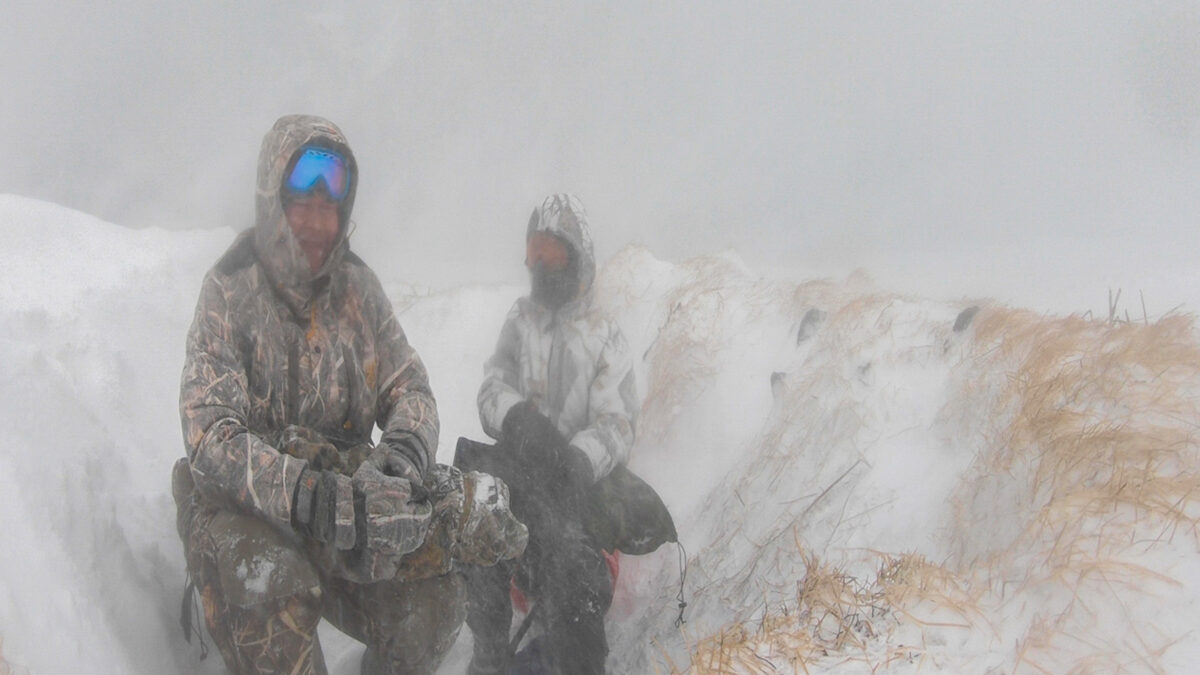
Ruins of an old house prove to be a good shelter from the wind. At least better than sitting out in the open. It was located 100 meters from the beach and less than one kilometer from the house.
After only 30 minutes a brown arctic fox came towards us and gave us a chance of a few shots. It danced around in the wind, curious of these new humans. After less than a minute it disappeared into the white snowdrift.
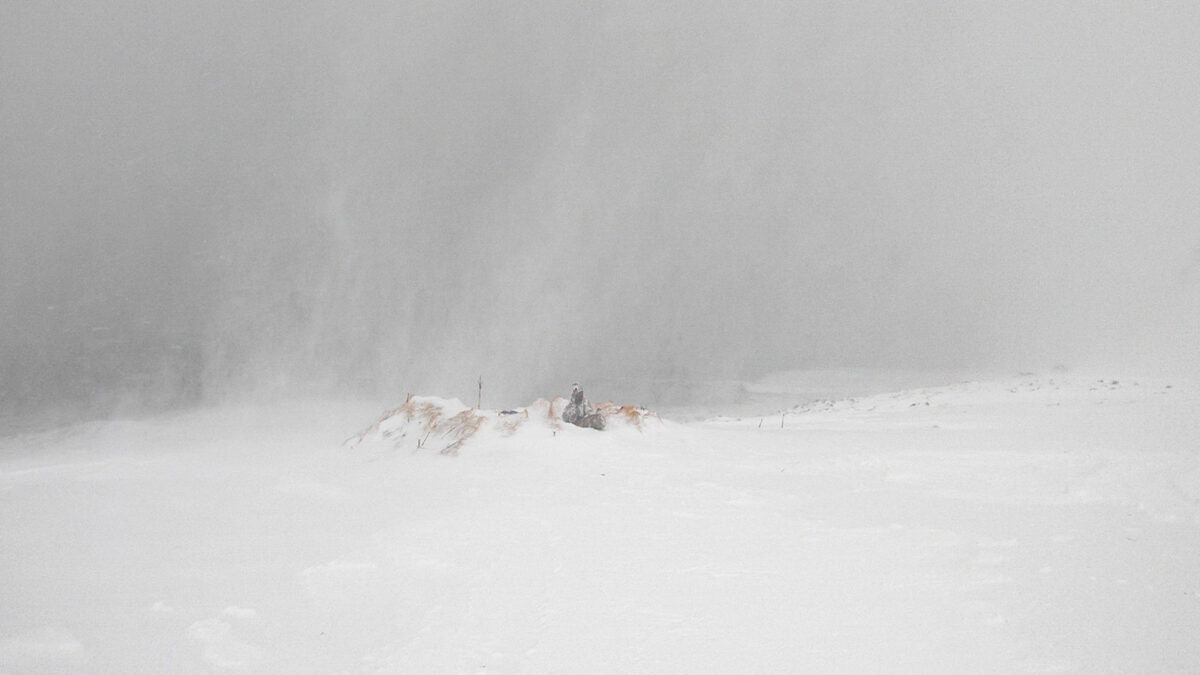
After waiting in the storm for less than one hour the brown fox appeared again in the snow-drift. This time another brown one followed, probably the male. They sparred in the distance in the heavy snowdrift, almost invisible to us. For a few moments they came quite close and gave us a chance of some shots. After a while, they disappeared into the white storm.
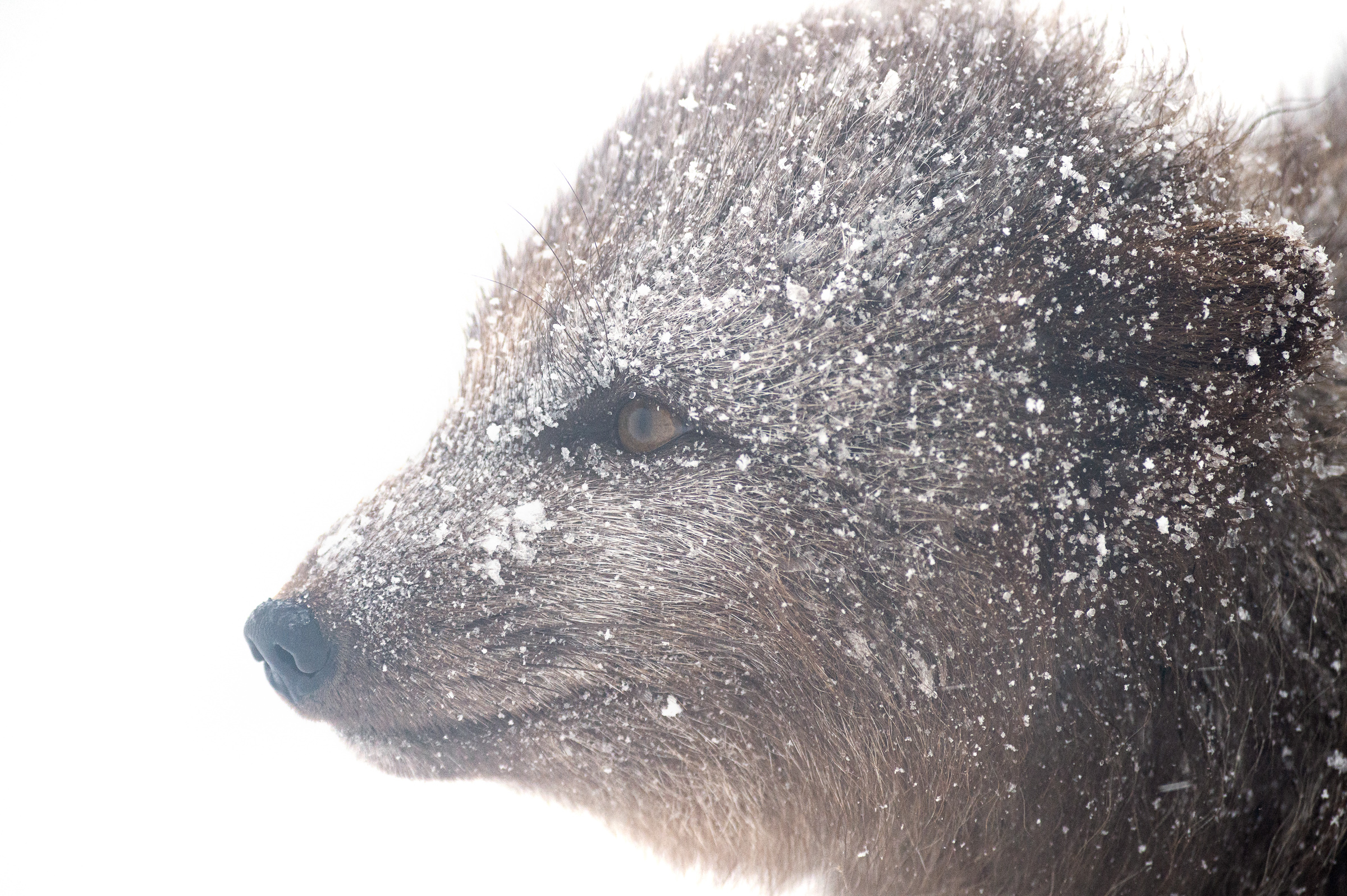
This was the last sighting of the two foxes. Moments after they disappeared we spotted a white fox running behind us and in seconds it disappeared into the snowdrift. We were excited to see it and hoped it would appear again, but after two or three hours waiting for nothing being battered by the wind gusts we called it a day. The light was fading.
Waiting in the snowdrift made the cameras and lenses all covered with snow and a moment’s drop in concentration where the lens was pointed into the wind meant having to use the lens cloths to get most of the snow off the lens.
This trip was my first experience with the Nikon Z6. We got one body a few days before leaving home and this proved to be working well. Gyda was shooting with Nikon D4s and Nikon D850 and I ended up using the Z6 most of the time. It proved to be excellent in these difficult conditions to make a long story short. I also used it to shoot video with autofocus – which is quite a new possibility for us Nikon users.
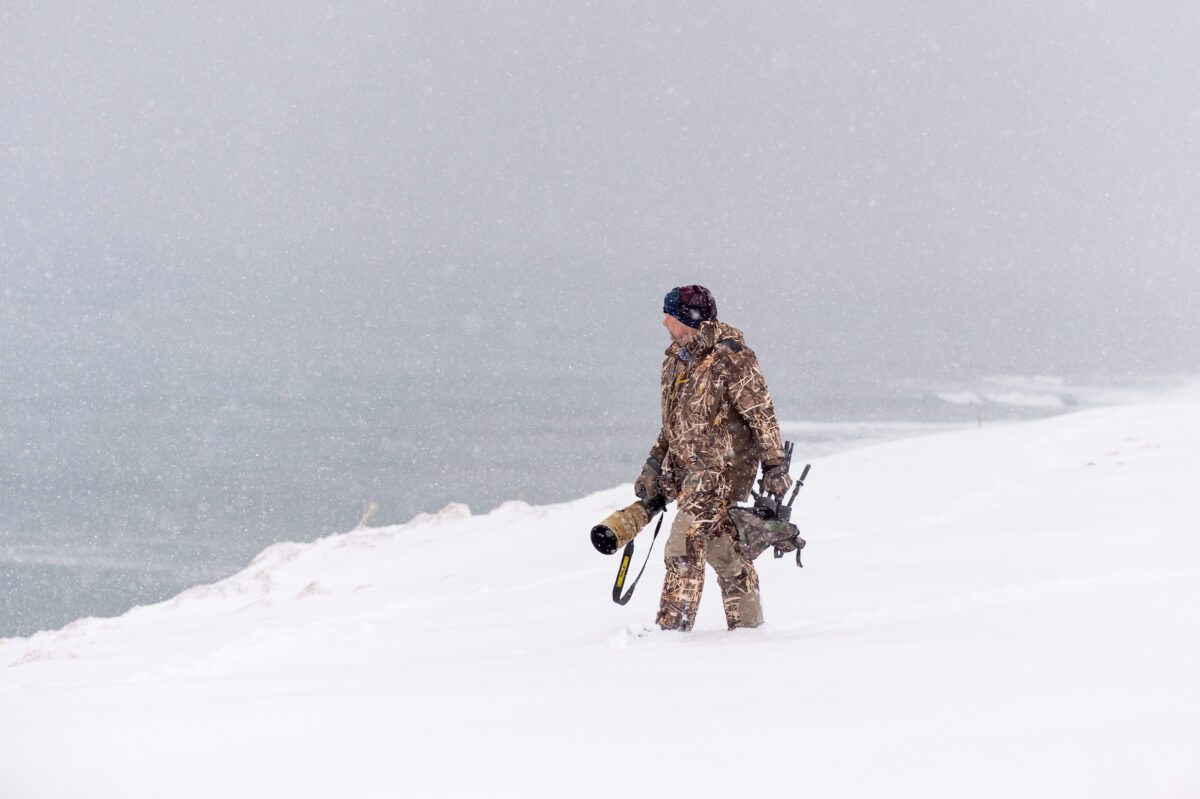
More crazy weather
On the third day, the weather was just as wild as the day before. It was difficult to stand outside and when walking we were swept off our feet a few times by the gusts. Gyda was often having problems walking straight, but we finally made it to our “shelter” in the ruins.
Arriving in the ruins around 10:30 it was too windy to see anything. This was the white world of a snowdrift. After three hours we headed back to the house. Nothing had happened and no foxes were visible. They probably were sleeping waiting for the weather to calm down. Looking down to the beach the waves were enormous.
In the afternoon we went out again. We walked along the beach and ended by going back to the shelter in the ruins. Nothing to see there after an hour of waiting, but suddenly a white fox came running in the opposite direction we had seen it the day before. It disappeared in seconds without us having a chance to take a shot.
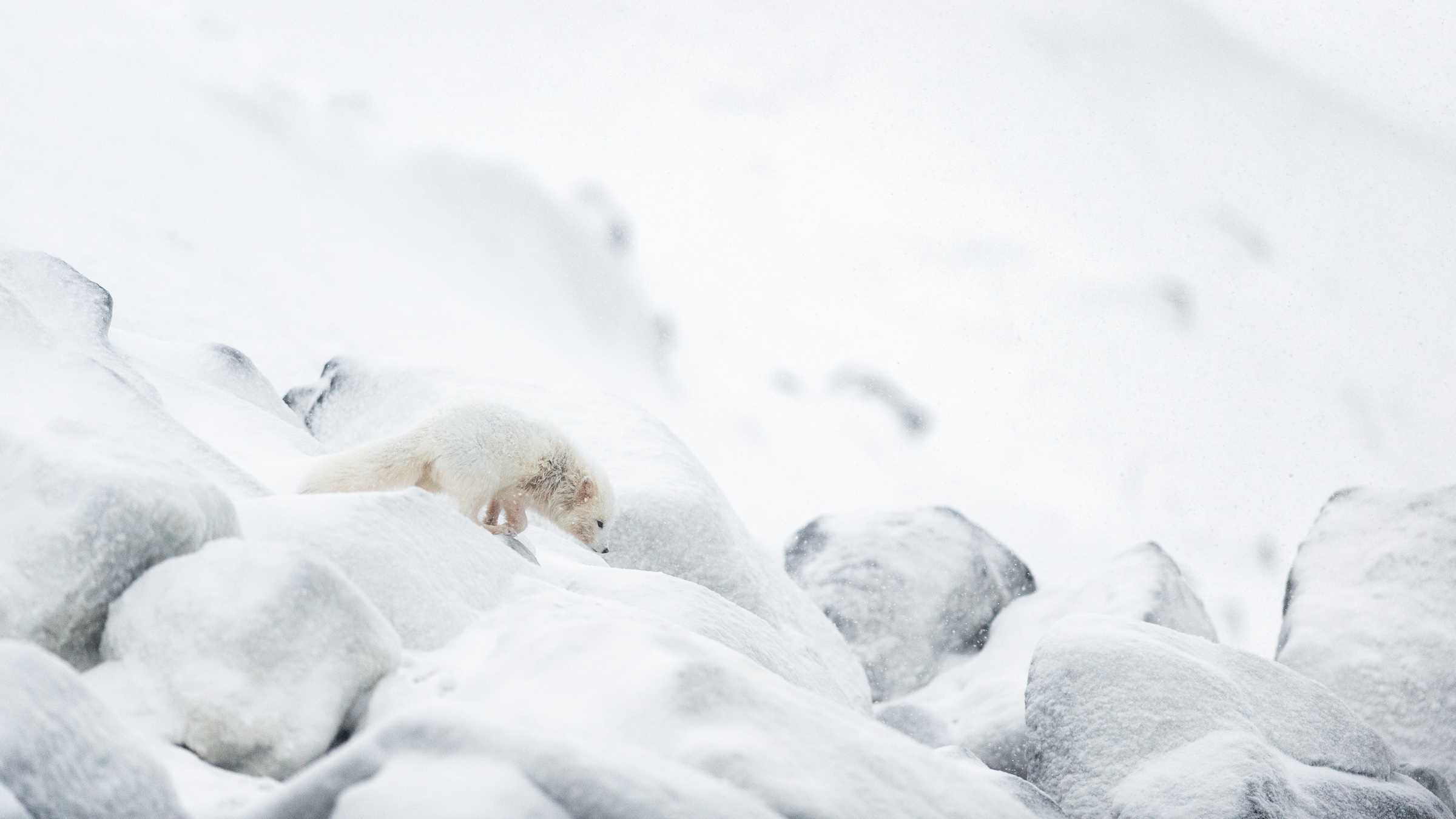
Going down to the beach and walking about 2 km to the south we came to a ravine where a small stream runs in the summertime. The snowdrift was sometimes overwhelming and often we were blinded when walking along the beach. Suddenly we notice a beautiful white fox searching for food between the rocks. It looked at us for a few seconds and then it kept searching. It probably decided we were not a threat.
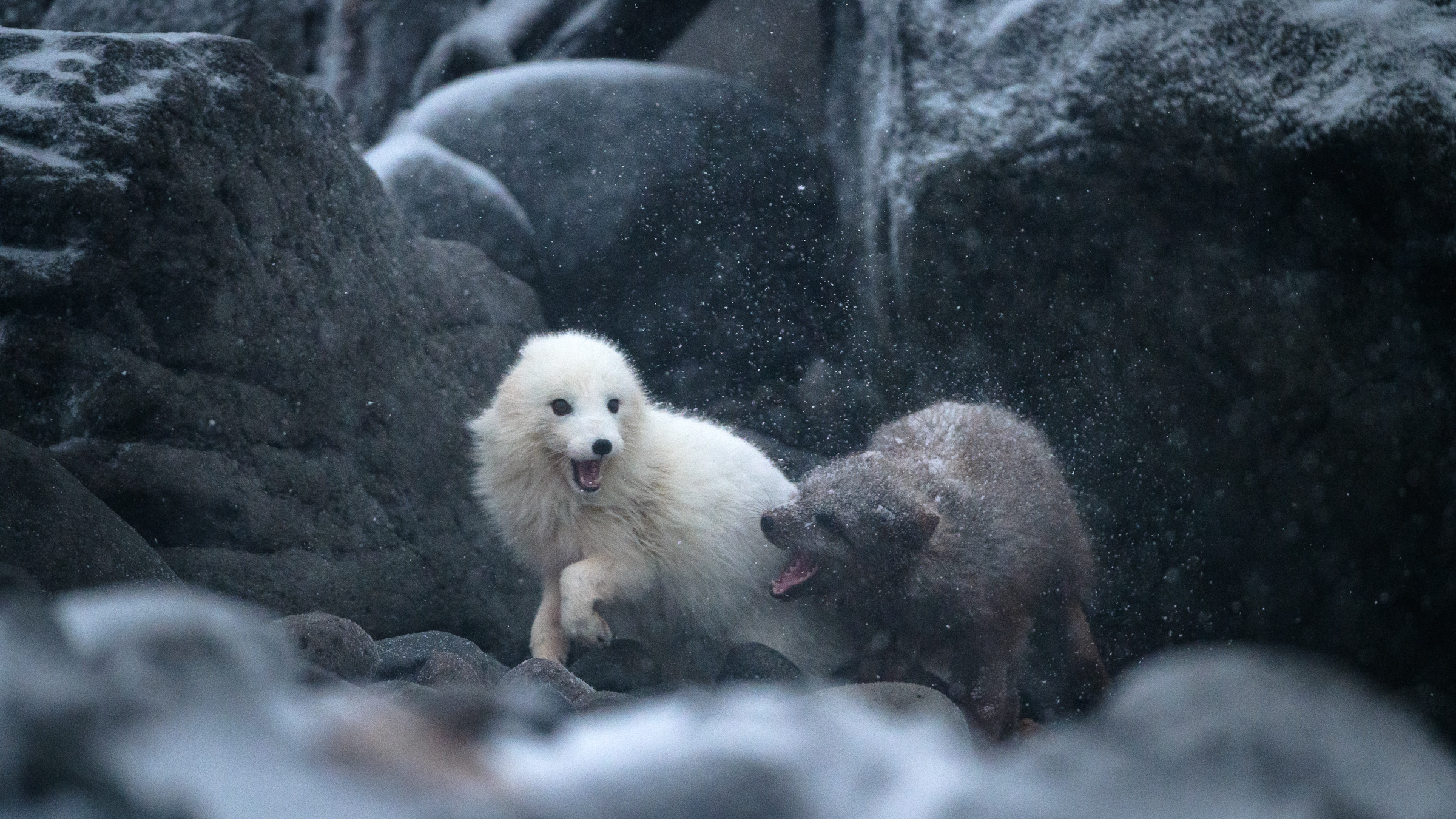
After watching the white one for 15 minutes a brown fox suddenly came behind it where it was focused on searching for food. They sparred for a moment and the brown one seemed to be the one in charge. Probably the male, since our experience is that the females are in most cases less shy. The males follow the females anywhere they go, even towards two humans photographing.
The time was 18:18 when we shot the first photo of the white fox. It was already getting dark and I was shooting at iso3200@f4 on the 500 mm lens. Soon it was up to iso4000 and one hour later at 19:20 when we shot the last photos of the foxes we were shooting between iso9000 and iso22800. Our goal is not to go under shutter speed 1/1000 – preferably stay around 1/1250-1/1600.
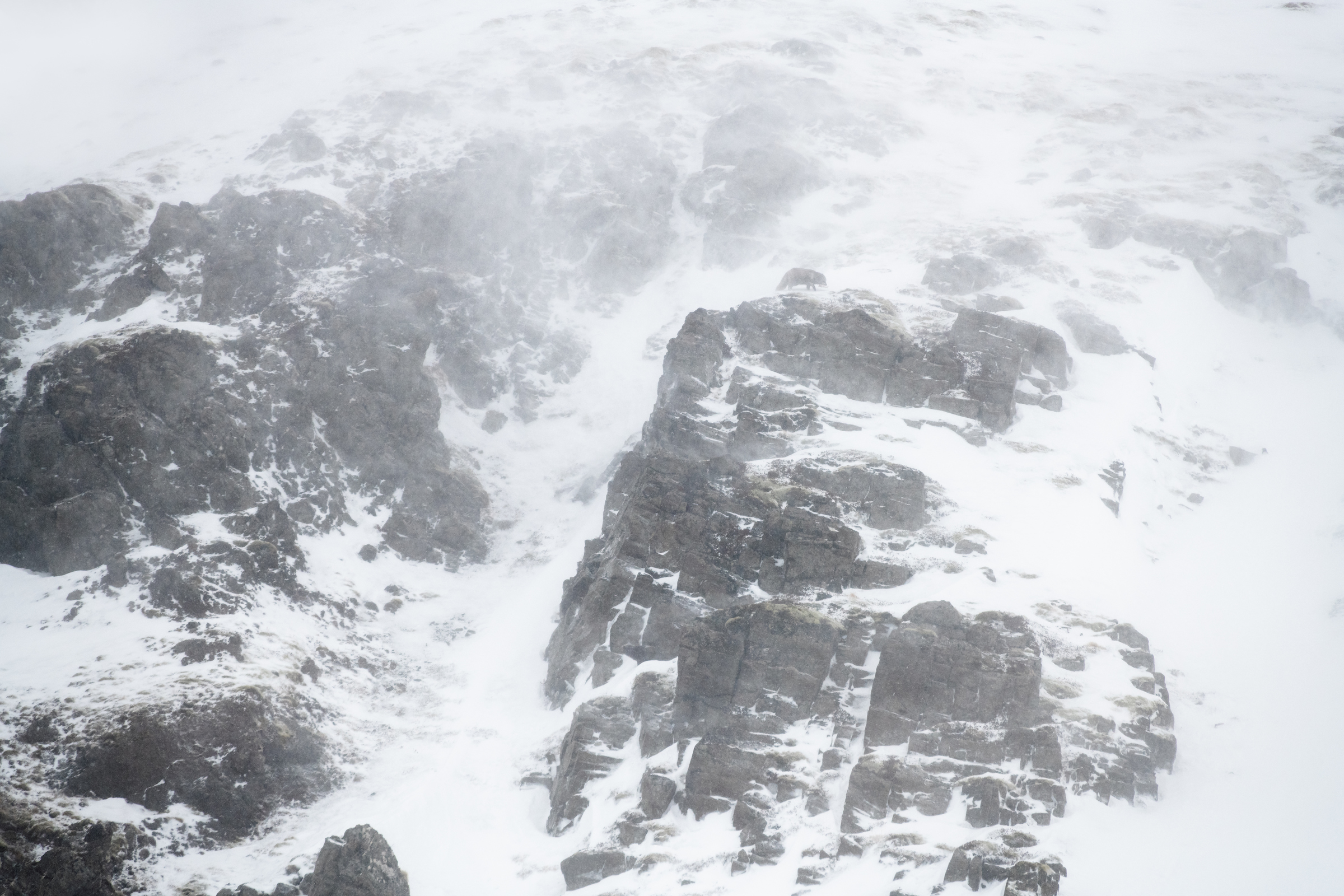
We left the foxes on the beach where they both were still searching for food. This was a happy ending to this day, but we were both wet and cold to the bone when arriving finally in the house. The mood was good though – we had bagged some shots.
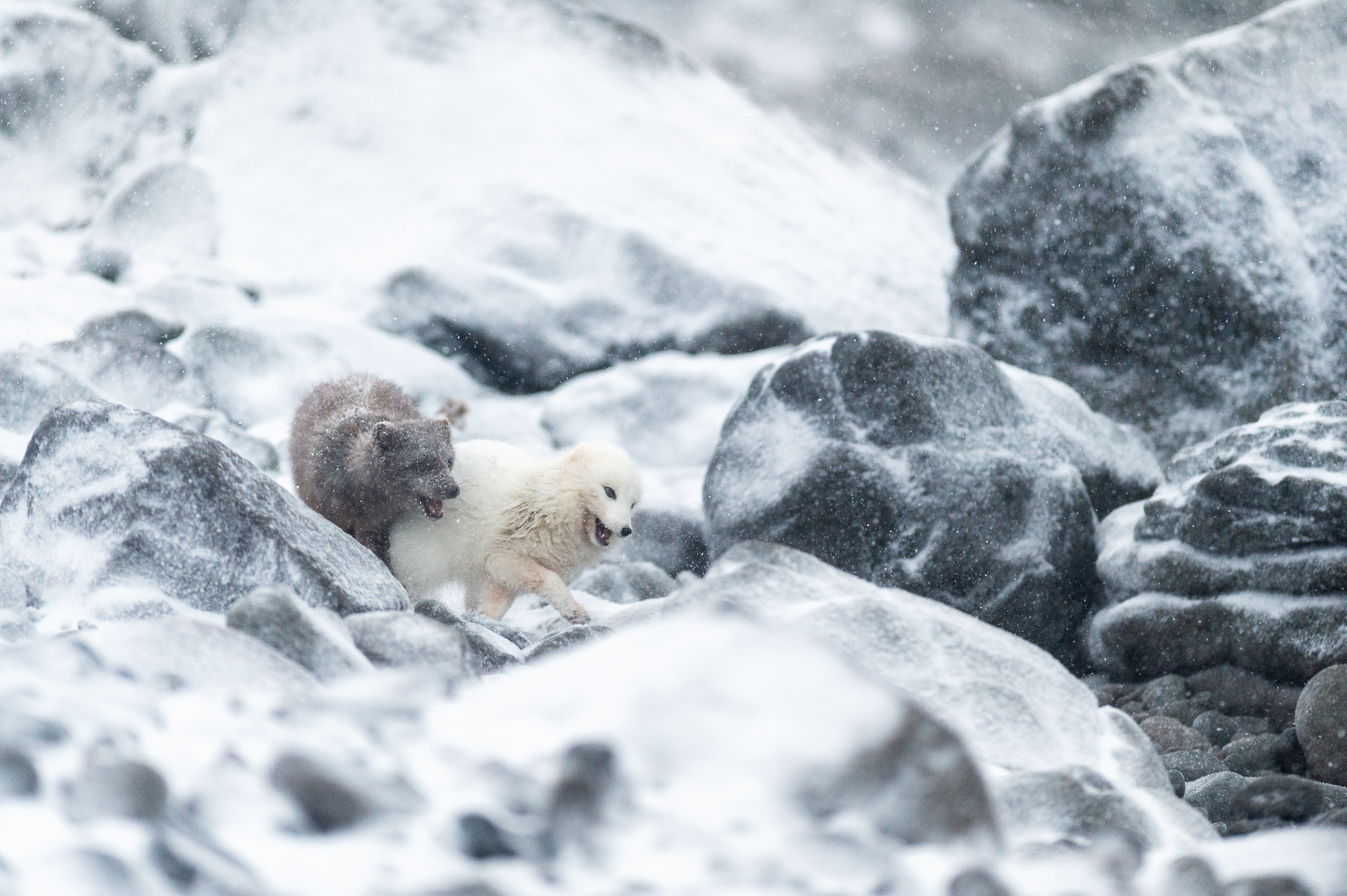
Dreams of white foxes
Waking up on the fourth day I felt like I had only dreamt white foxes for the whole night.
Going out we dressed for walking, not waiting. I had the Z6 on the 500 mm lens and the small Z-24-74 in my pocket. Gyda took the D850 on 300 mm F2.8 VRII and also a D4s with 105 mm macro.
This was a long day of walking. The weather was still almost as crazy as the past two days had been, but once in a while the wind calmed down. We walked twice along the shore to the location where we had met the foxes the day before. Despite the weather being not as bad as it had been we did not get close to any foxes. Twice we saw a pair in the distance but we had no luck getting close enough for photography.
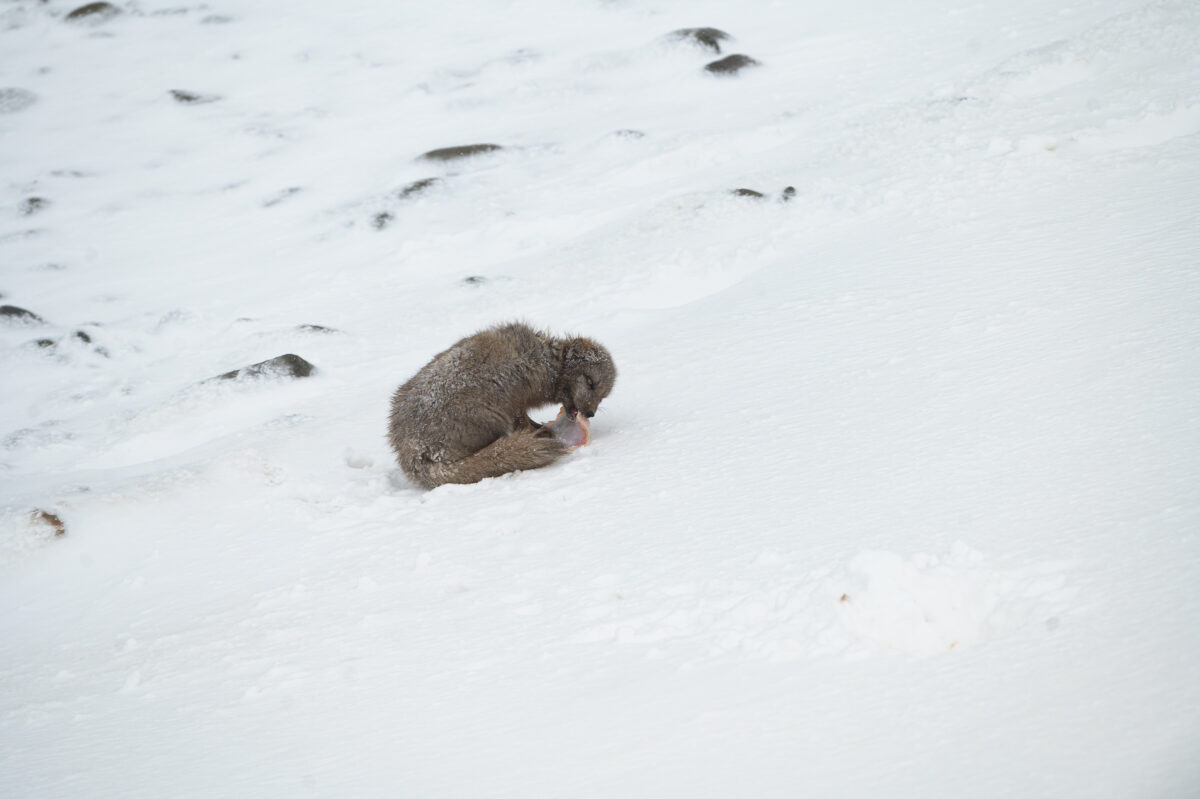
On the way back a brown fox was eating a large piece of a flatfish in the snow. It had dug a hole and hidden the fish there. This was the only opportunity to bag a shot for the whole day despite walking more or less for the whole day many kilometers.
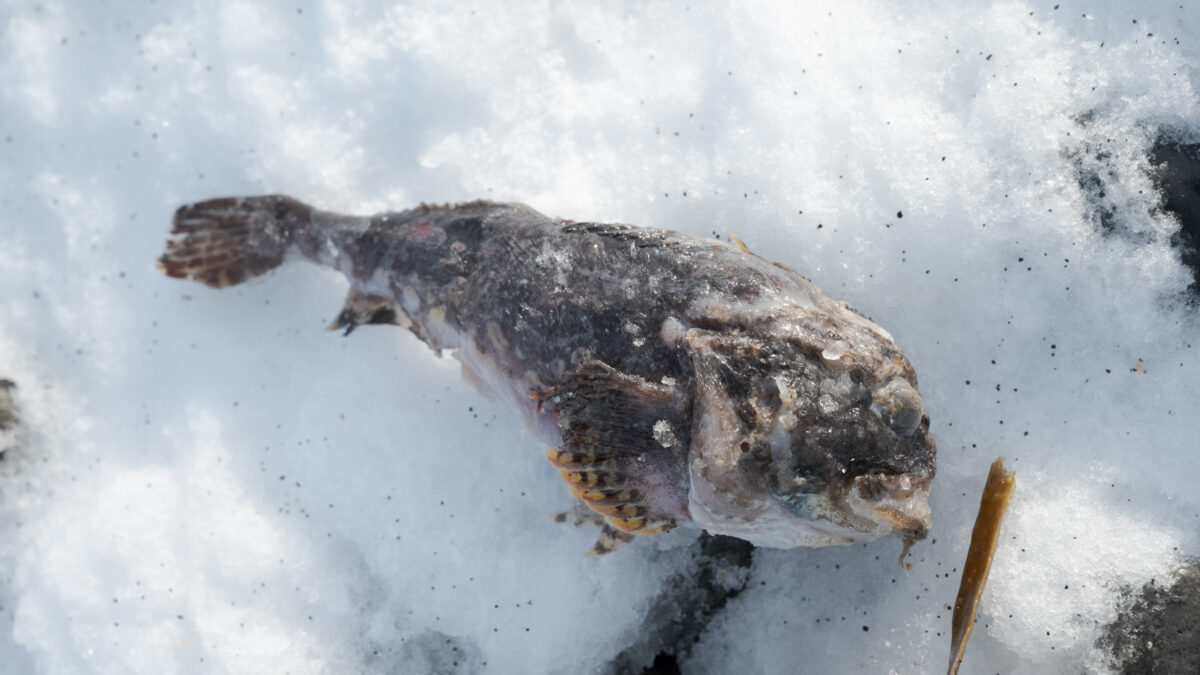
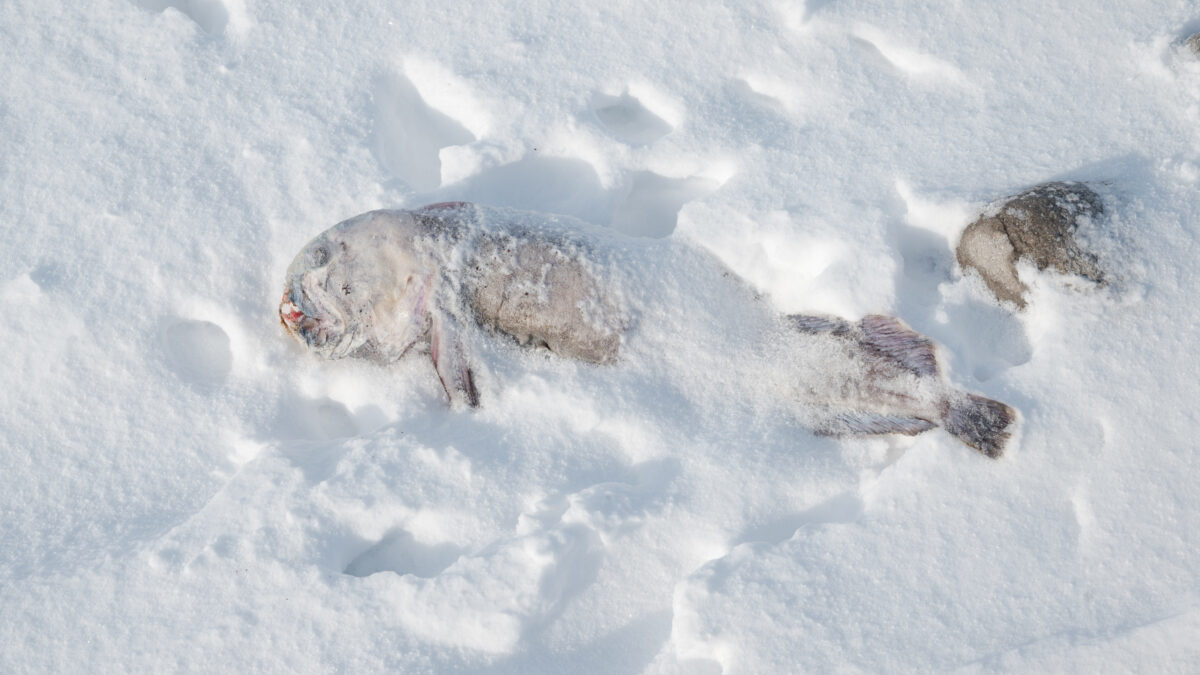
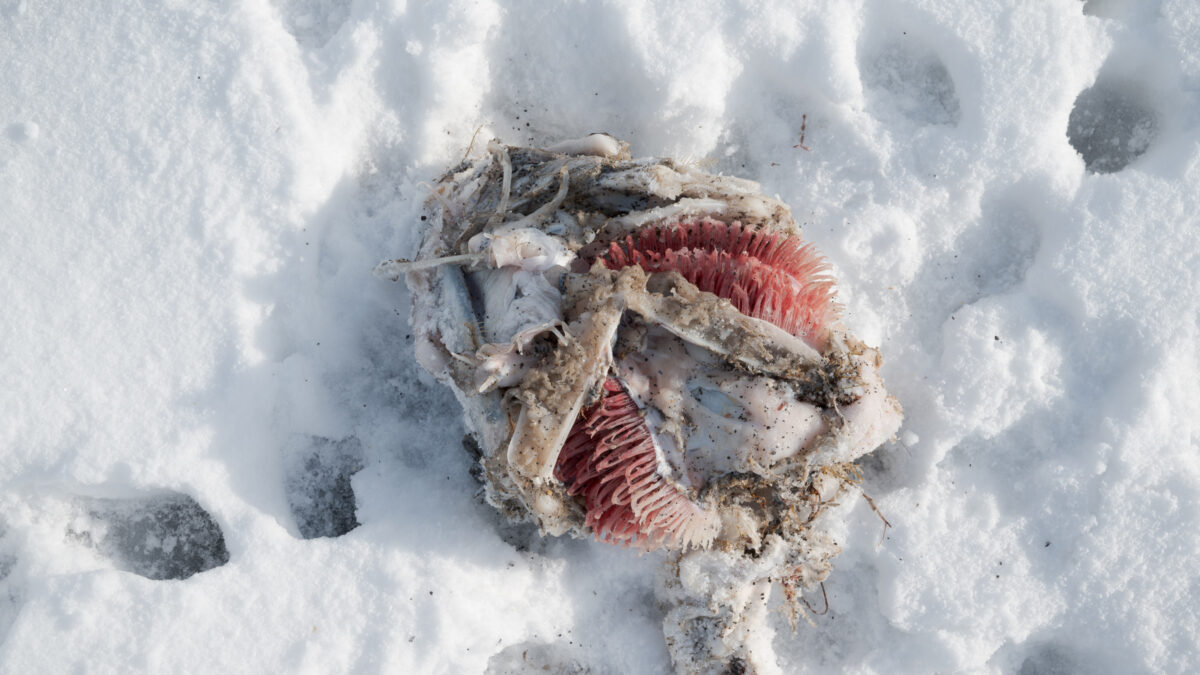
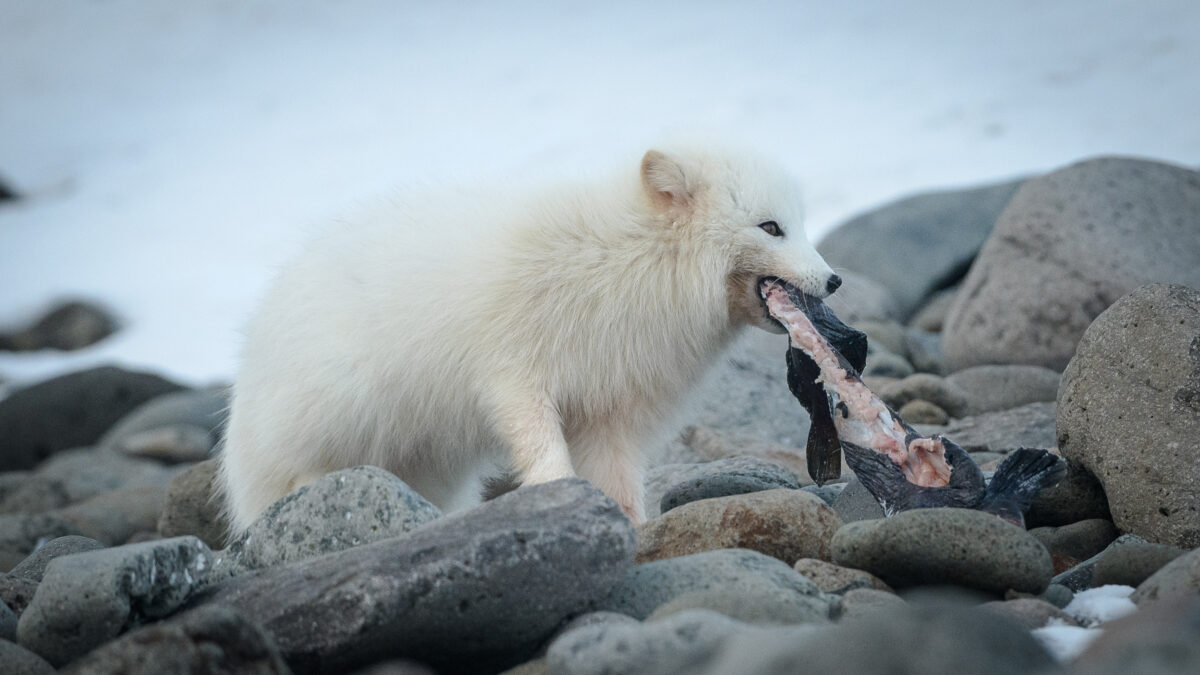
Now that the weather had calmed a bit we made a discovery; the beach was full of fish. Mostly it was catfish, but also sea cucumber, plaice, cod, monkfish, starfish and father lasher to name a few. Even eggs from whelks were all over the beach. This must have been due to the weather in the past two days. The waves chrashing on the beach were enormous. One thing was sure; the foxes would not starve for the coming months.
The fact that the arctic fox lives through the winter by finding fish and food along the shoreline is not much discussed in Iceland. Hunters like to draw attention to the fox killing ptarmigans and birds. The fox would not be able to live in Iceland unless being a opportunist and eat everything, but fish as a main food source in the winter has not gotten much attention in the discussions. It is likely that in large part of the country it lives through the toughest wintermonths by finding food along the shoreline.
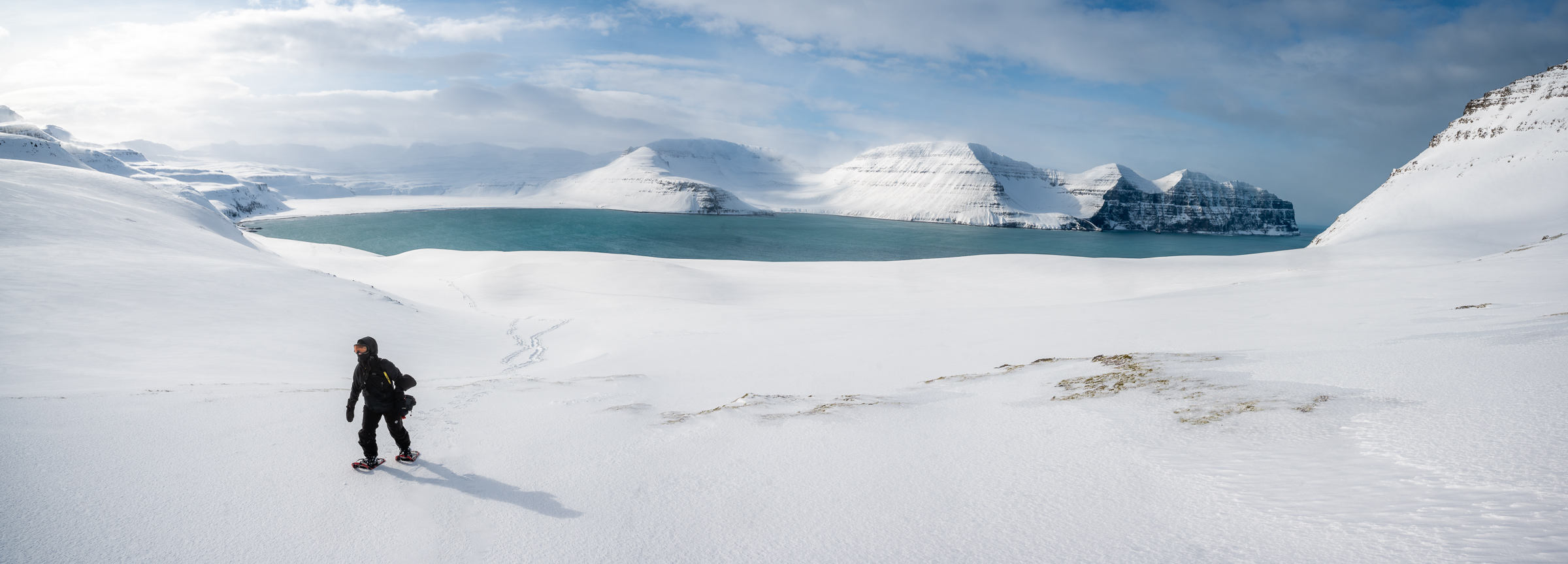
Finally good weather
At last we got good weather on day five. It was windy, but nothing in comparison to the storm for the past days. We put on our snowshoes and walked up the mountain into the walley named Miðdalur. It was tough walking on snowshoes in warm clothes, but the plan was to photograph the mountains and landscapes and preferably get a photo of a fox with the mountain in the background.
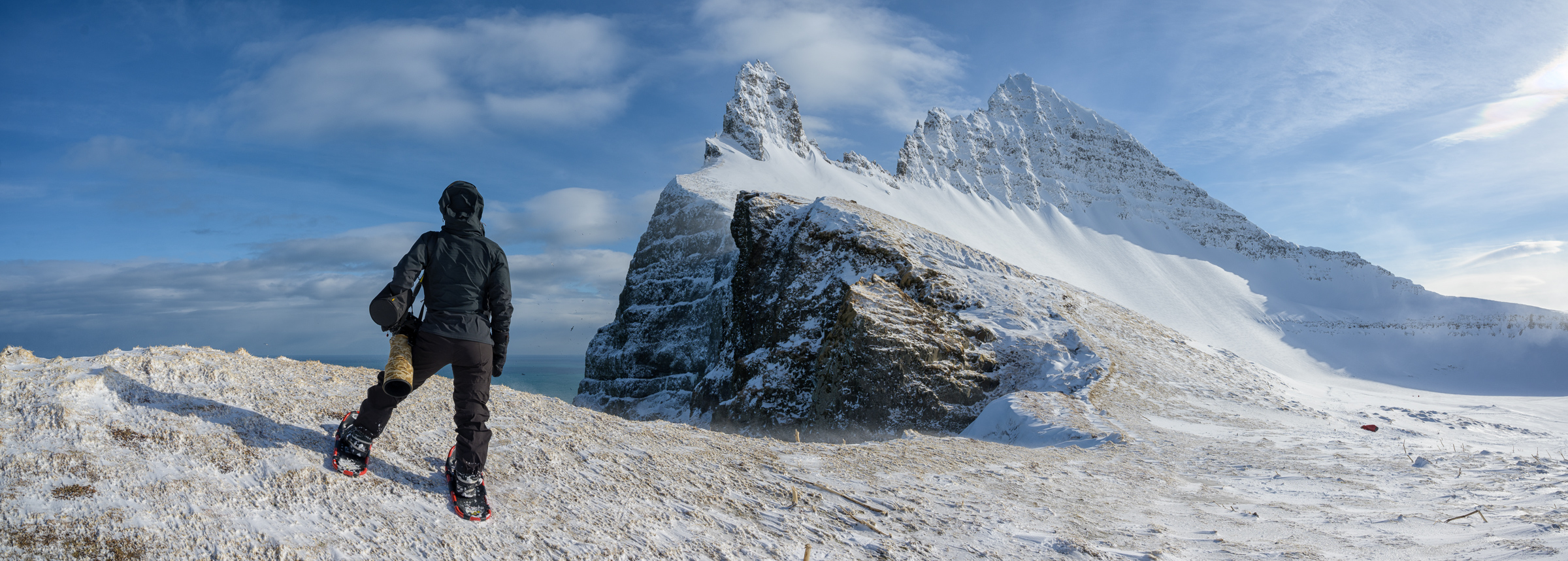
Next time I will try to remember that 500 mm lenses have no business in the mountains. Dragging the beast up the mountain in a bag should not be repeated.
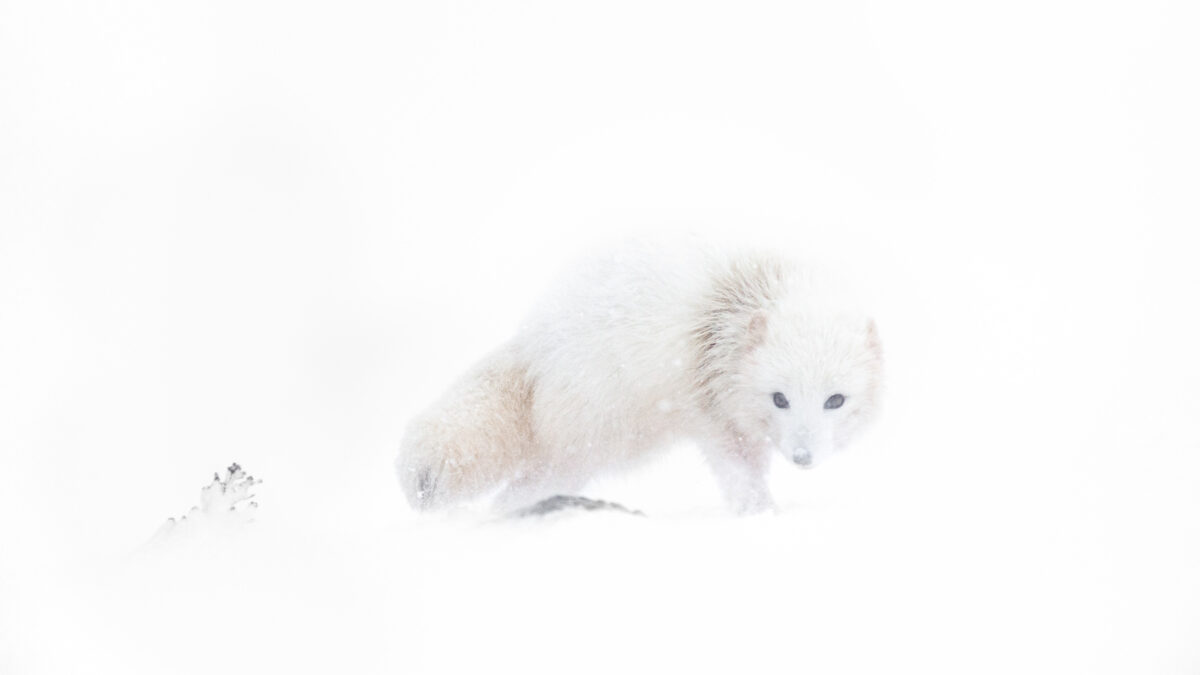
In the afternoon we came back to the house after the long walk. We were still with some energy left, so we went to the shore and there we found the white fox and shot it with the 24-70 lens and the longer lenses. It was very calm and came within few meters from us.
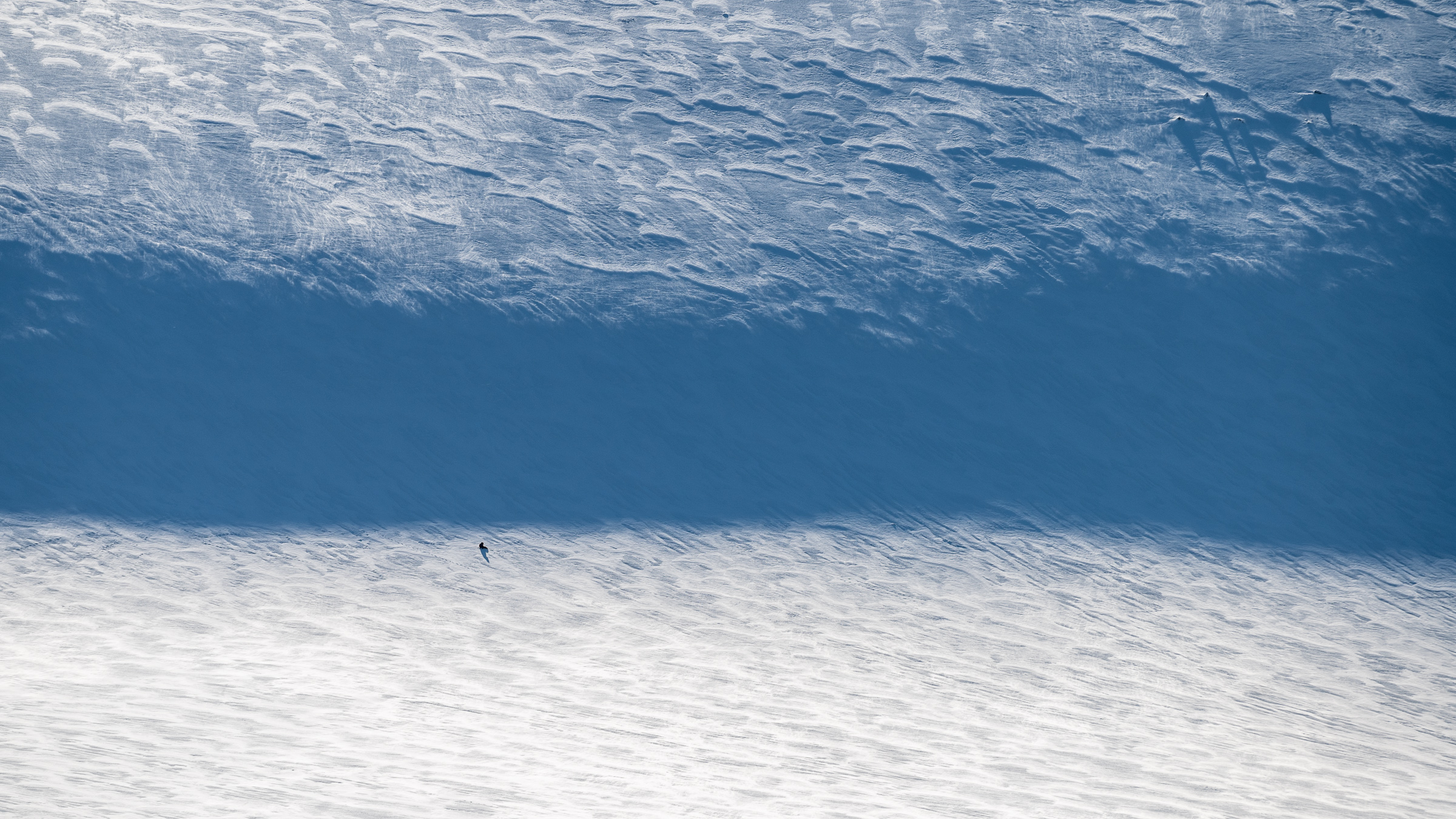
The worst weather
Waking up on day six was a bit of a disappointment. The weather was of the worst kind. Sleet, rain and high wind. After only five minutes outside everything was wet and cold. The snow was melting and the conditions were as bad as they get. We stayed inside for the whole day.
Day seven was bright and the wind was moderate. I installed a trap camera in a location where a fox in the foreground would have been a great landscape shot. To make a long story short, it did not work. The foxes did not come close to the setup.
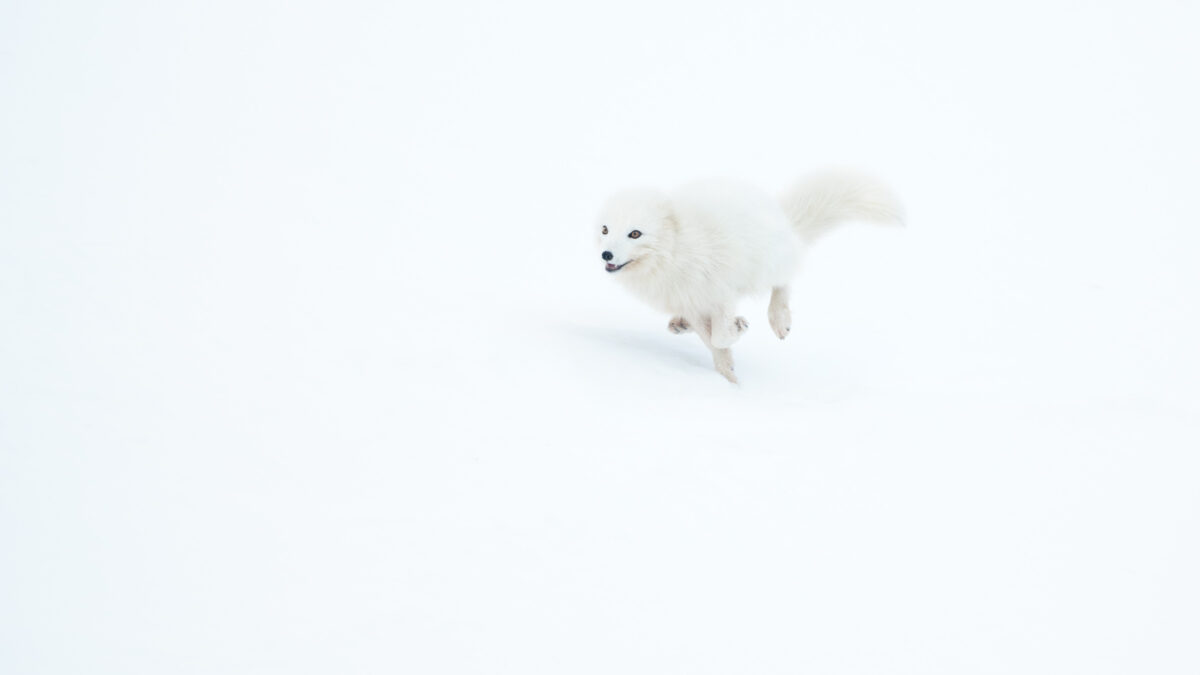
In the afternoon we went to the location where we had met the white fox. After waiting there for a while behind rocks we saw both white and brown foxes sparring and running in the distance. The brown one was chasing the white one and finally, they came running along the hill above the beach to us.
It was exciting to see them come running and as soon as they reached us the white one kept running and the brown one stopped. Our location was the border of two territories.
Drone problems
Conditions in the morning of day 8 were drone conditions. No wind and mostly cloudy. I flew the drone (Phantom 4 Pro+) along the shore and the idea was to get a shot of the bay with Horn – the biggest cliffs. This did not go as planned since the drone lost connection every time I got close to the mountain. It was only when I walked along the shore to a more visible location that I managed to get the shot – on the third and last battery.
I was happy to have success in photographing the bay since this was my only chance to do so. It was not an option to charge the drone batteries.
Around noon the wind picked up and the familiar snowdrift and wind-gusts came back.
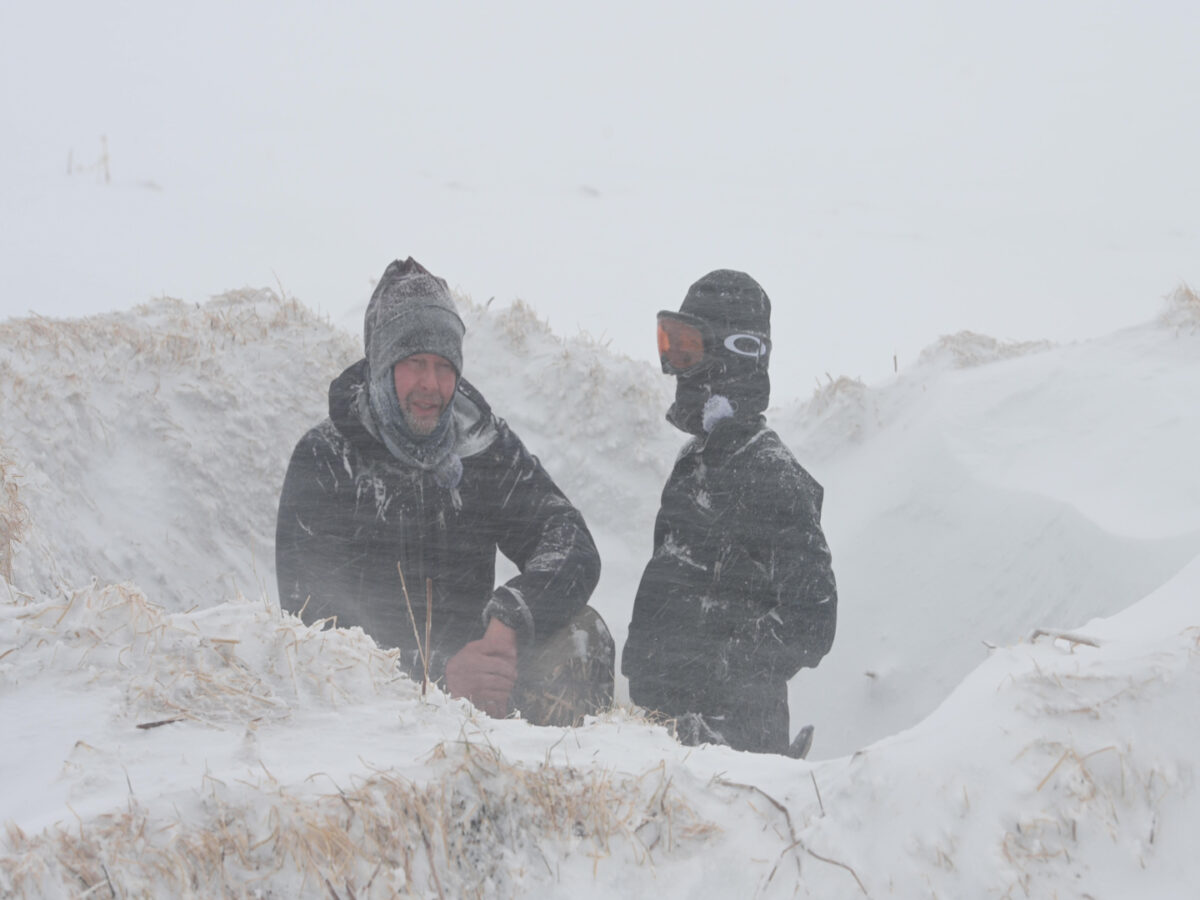
Learning new things
Everything was wet. Clothes, cameras, and us. This was day no. 9. The weather was a mix of snowdrift and sleet. We found no foxes to photograph and this could possibly be our last day. The plan was to go home on day 10, but we had not heard from the captain and the weather was not promising for tomorrow.
We spent the day relaxing and making videos outside the snowdrift, trying to speak to the camera. Photographers should never be on the wrong side of the camera, but we need to be open to learning something new. Making content for our YouTube channel was a experiment and a learning process.
It was also useful to stay inside and write notes on what could be done better. We made notes on what equipment we should bring next time and what we did not need. Some of our clothes and equipment were great – some less great.
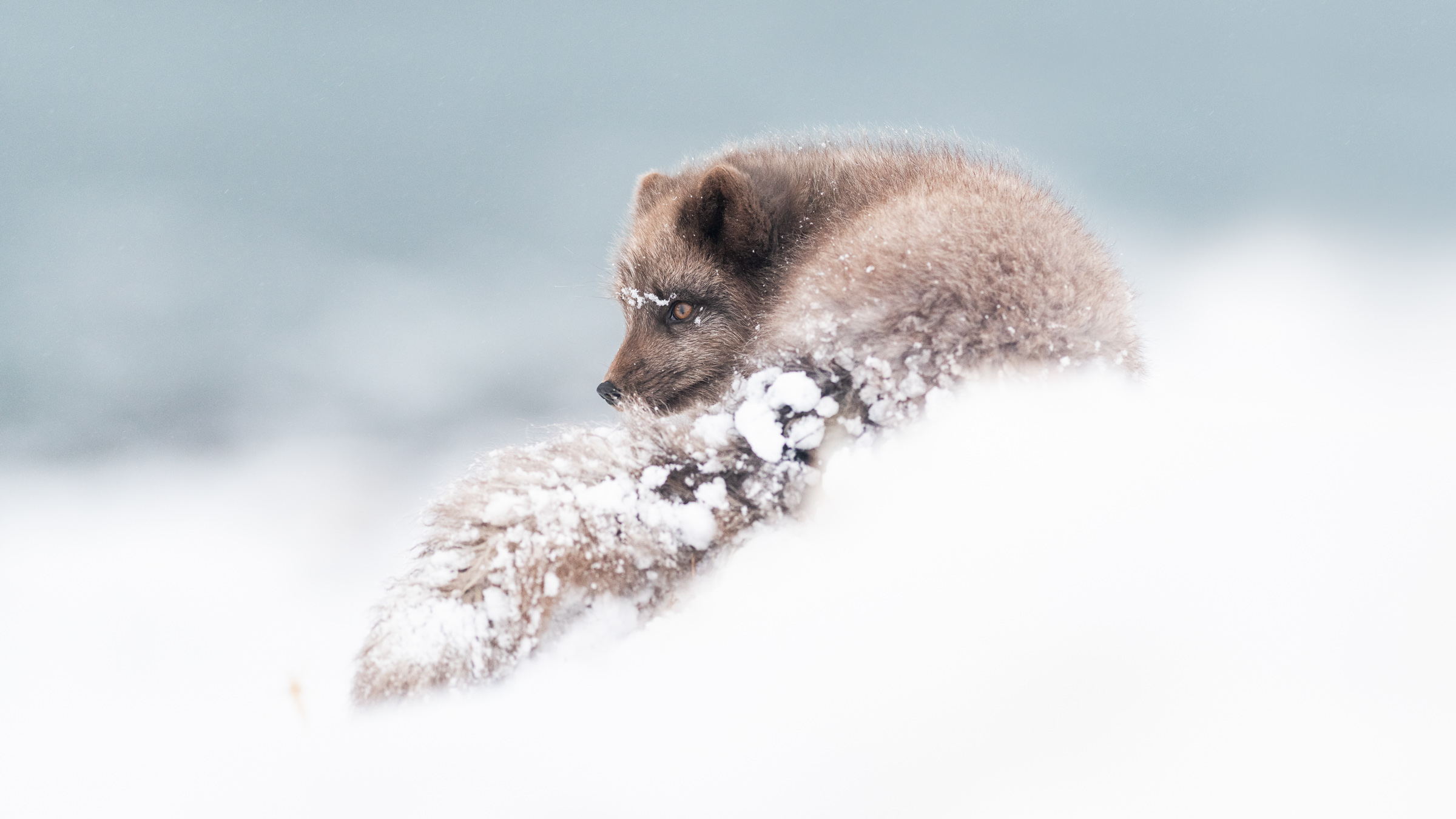
Tips for photographing in snow conditions
Exposing to the right is extremely important. Most cameras try to make snow look gray, depending on the light metering. Depending on what camera is used it is important to expose the image so the histogram is mostly to the right when the subject is mostly white snow. If using Aperture Priority and Matrix metering this means overexposing by 1 or 2 stops. This is important since most of the time high iso is needed and there is a huge difference in the quality of the image if needed to lift shadows in the editing process. When the subject is a brown fox in completely white snow this is very important.
Using Manual mode this is solved by keeping a constant eye on the histogram and making sure it is on the edge of blowing the highlights. This is easy in mirrorless cameras when it´s possible to see the histogram in the viewfinder.
Using Aperture mode this is possible by overexposing, but the problem is that if the subject (brown fox) comes too close the overexposure might be too much. This is though seldom a problem.
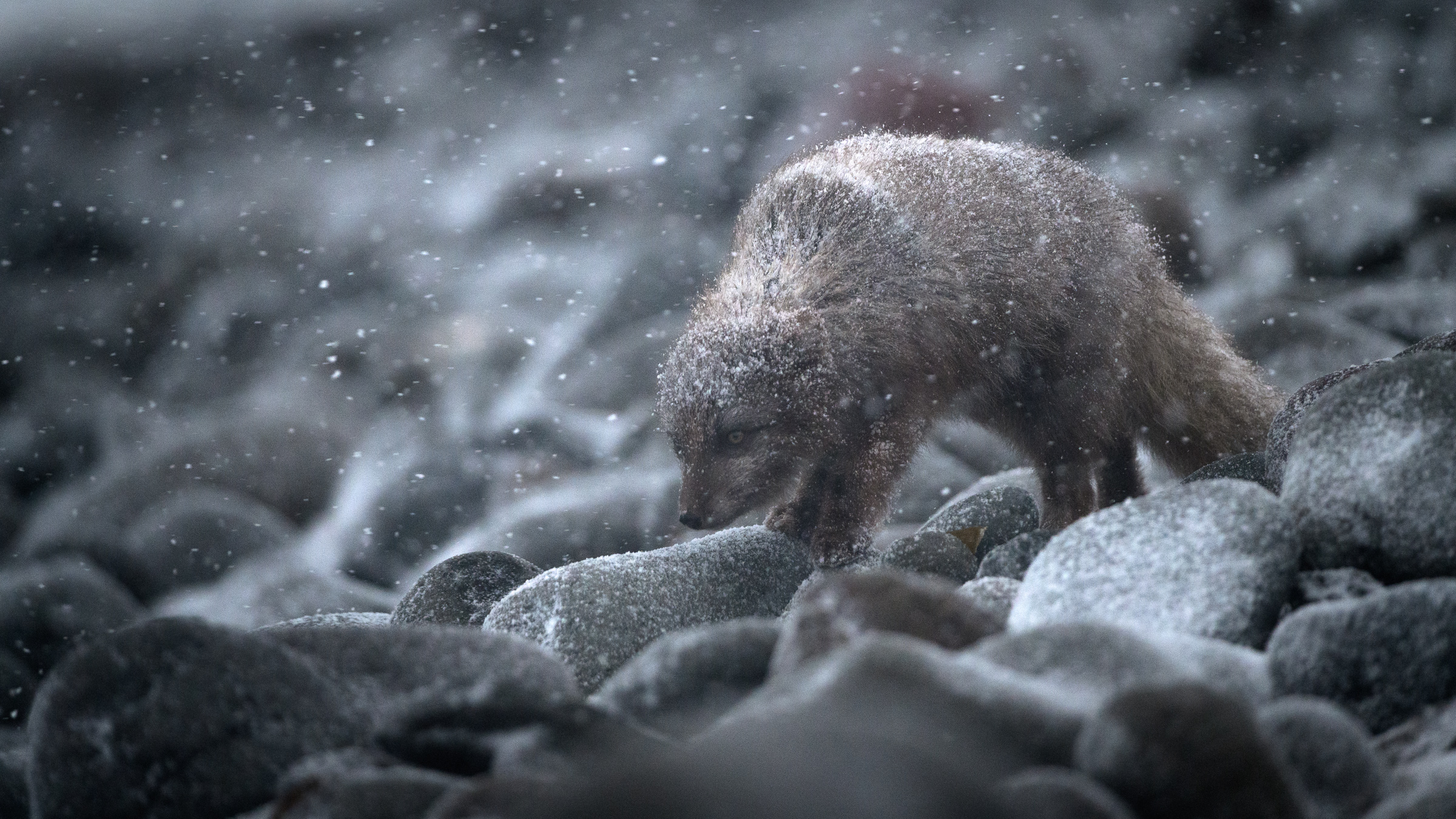
More snowdrift
Looking outside of the window when making the coffee for breakfast on day 10 the conditions offered more of the same. Snowdrift and gusts of wind blowing snow in all directions.
We went early to the ruins and waited there. Nothing happened.
Next time I hear someone state the popular comment: “It is so easy to photograph arctic foxes in Hornstrandir”, I will shove my empty memory card up his nostrils.
At exactly 18:30 the wind and snowdrift suddenly ceased and foxes were visible in the far distance. Gyda walked to the north end of the bay hoping to get close to some of them and I walked in the opposite direction towards the territorial border in the south end of the bay.
Not much happened until I was on the way back. Suddenly a brown fox came running from the mountain and went straight to the beach. Now the snowdrift was back. I lay flat on my back in the snow with the 500 lens on my right knee. I shot a video of the fox walking towards me. It seemed no to notice me until it was too close for the minimum focusing distance of the lens. It jumped a few steps back when it noticed my movements and I switched from video to a headshot photo. This would only be possible on the Nikon Z6 – not the other DSLRs we have.
Late in the evening, we got a message through the satellite system: The boat would pick us up tomorrow.
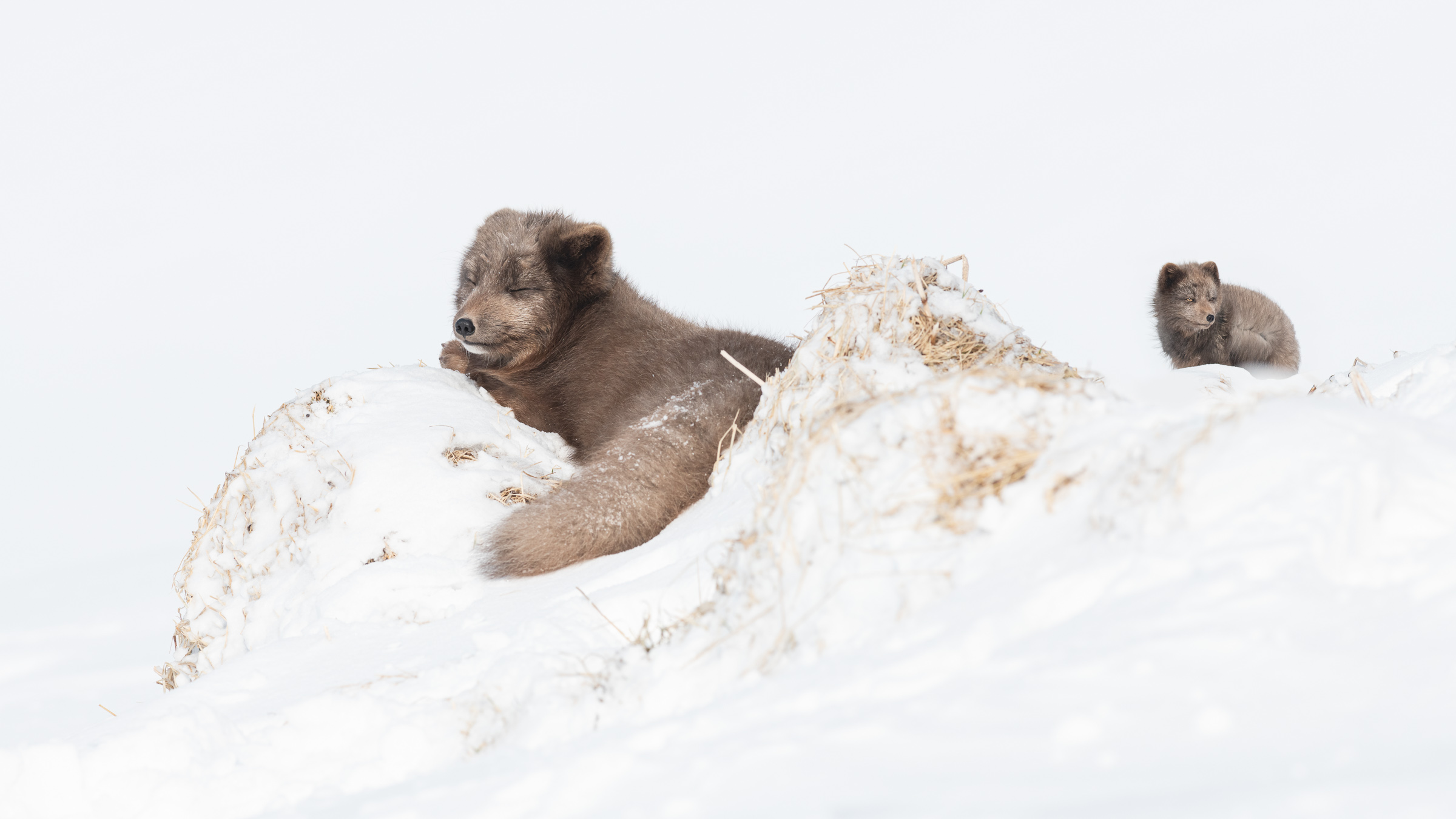
Day of departure
Everyone was busy packing and preparing for departure. This was the best weather we had had for the past 11 days and now three foxes came all the way to the house as if they were there to say goodbye.
A pair was very calm and came within 15 meters of us near the house. The female relaxed on a tussock nearby and the male kept an eye on her with the third fox – a competing male not far away.
Just before the boat came to pick us up the female walked near our luggage. It sat down and seemed to look curiously over the various gear. We were leaving and this felt like a goodbye from this hardy animal. It would be months until it would see humans again.
We made a video about this trip on our YouTube channel.

